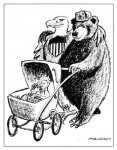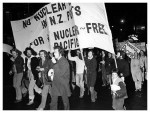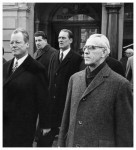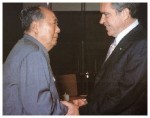
During the 1960s there was a slight but noticeable easing of tensions between the United States, Soviet Union and some of their allies. This decade-long thaw in international relations is known by various names. In the West it was called Détente, in Soviet Russia razryadka and in West Germany Ostpolitik. The period of Détente saw better communications and a greater level of respect between the nuclear superpowers. While Détente did not end the Cold War, it produced some significant achievements. The willingness of both superpowers to communicate led to arms reduction summits, the signing of anti-nuclear proliferation agreements and a reduction in nuclear arms stockpiles. There was political recognition of communist nations by the West, the most significant of which was Richard Nixon‘s 1972 visit to communist China. Détente also brought about improved diplomacy and even some minor economic and trade agreements between East and West. Détente was a period of understanding and mutual acceptance by both Cold War superpowers. While their ideological and economic systems rendered them incompatible, both acknowledged the need for negotiation, compromise and working together.
There are different opinions about the nature of Cold War Détente. To some, Détente simply marked a normalisation in superpower relations; it became impossible for leaders to maintain the hostility and belligerence that had existed for a quarter-century. Some attribute this change in attitude to a change of leadership. In the first decade of the Cold War, foreign policy had been defined by assertive ideologues like Joseph Stalin, Harry Truman and John Foster Dulles. By the late 1960s and early 1970s, however, these men were long gone. They had been replaced by political pragmatists like Richard Nixon and Leonid Brezhnev. Détente-era leaders also had to wrestle with domestic issues as well as Cold War struggles. Economic changes and conditions rendered arms spending and direct confrontation costly, dangerous and unpopular. Governments had to find new, more sophisticated and subtle ways of waging the Cold War. Raymond Garthoff supports this idea, suggesting that Détente represented a change in methodology, not a ‘winding down’ of the Cold War:
“The agreements [of Détente] cannot be said to have played any substantial role in affecting the course of the Cold War and its final settlement. They did not have any weakening effect on US or Western resolve or behaviour, as some critics had feared, nor can it be demonstrated that they moderated the pursuit of advantage … as both continued to wage the Cold War. Détente was a more sophisticated and less belligerent way of waging the Cold War, rather than an alternative to it.”
Some of the factors that contributed to the rise of Détente included:

Fears about nuclear weapons. The Cuban missile crisis of 1962 triggered paranoia and public concern about the dangers of nuclear war. Over time, nuclear powers came under international pressure to reduce stockpiles of nuclear warheads and missile systems. Pressure groups like the Campaign for Nuclear Disarmament (CND, formed 1957) and Greenpeace (formed 1971) lobbied against the further production and proliferation of nuclear weapons. American stockpiles of nuclear weapons peaked at more than 30,000 in the mid-1960s, then slowly declined. In July 1968 the US, Soviet Union and Great Britain signed the Non-Proliferation Treaty, an international agreement to limit the spread of nuclear weapons while working towards nuclear disarmament.
Economic factors. The Cold War arms race was a costly business for both superpowers. Both the United States and the Soviet Union faced additional, though contrasting economic problems during the 1970s. America spent billions of dollars on its involvement in Vietnam, while the Organisation of Petroleum Exporting Countries (OPEC) oil embargo of 1973 also led to disruptions in oil supply, higher fuel prices, a stock market slump and other detrimental effects on the US economy. The Soviet economy, which had grown rapidly through the 1950s and 1960s, began to stall after 1970. Of particular concern was a lack of growth in the agricultural sector, which caused food prices to increase by between 50 and 100 percent. Having to prop up several failing Soviet bloc states placed additional strains on the Russian economy.

Domestic issues. During Détente, both major powers were distracted by internal problems that drew attention away from foreign policy. In the US, domestic opposition to the Vietnam War and military casualties incurred there limited the possibility of strong military action elsewhere in the world. America in the early 1970s was also distracted by the Watergate scandal, which ended in 1974 with the resignation of Richard Nixon. The Soviet Union was preoccupied with economic problems, such as falling crop yields, internal opposition and problems within the Soviet bloc. Brezhnev dealt with opposition by winding back some of the liberal reforms implemented by Nikita Khrushchev, expanding the powers of the KGB and tightening press control and censorship.
The Sino-Soviet split. Through the 1960s, ideological differences and domestic political events caused the Soviet Union and the People’s Republic of China to drift apart. By 1967, Moscow and Beijing were barely on speaking terms. Two years later, border clashes between Russian and Chinese soldiers threatened to plunge the two nuclear powers into a full-scale war. It was later revealed that Soviet Russia had developed more nuclear battle plans against China than against the United States. American planners saw advantages in encouraging and widening the Sino-Soviet split. They did this through covert and diplomatic means, such as Richard Nixon’s visit to China in 1972.

Ostpolitik. In West Germany, the 1969 election of Willy Brandt as chancellor heralded a new approach to the Cold War there. Brandt was more left-wing than previous West German leaders, though far from a communist. He favoured rapprochement, or the restoration of friendly relations, with East Germany and other Soviet bloc nations. Brandt’s foreign policy, dubbed Ostpolitik (German for ‘eastern policy’), was a more practical and realistic attempt to bridge the Iron Curtain. The most important step, Brandt argued, was to permit and encourage trade deals with East Germany. He believed these new trade links would encourage greater communication and cultural exchange, making Soviet bloc nations less defensive and more open to reform. Brandt’s Ostpolitik was very unpopular with conservatives, both in West Germany and internationally, however it was generally successful and played an important role in reducing European tensions. Ostpolitik also referred to a similar approach employed by Pope Paul VI and the Vatican, who sought greater communication with the leaders of Soviet bloc nations.
“In the early 1970s the Nixon administration claimed that the era ‘of confrontation’ with the Soviet Union was at an end, and that the era ‘of negotiation’ was beginning. In 1981 the Reagan administration came to office not with a commitment to negotiate with the Soviet Union but a promise to restore American strength and prestige. The 1970s were characterised by the incoming administration as a ‘decade of neglect’ in which the United States – seduced and blinded by Détente and hampered by Vietnam and Watergate – had failed to provide for its own security.”
Mike Bowker, historian
The onset of Détente produced several international visits and bilateral conferences. In 1972, with the Vietnam War still raging, US president Richard Nixon visited communist China, where he met the ailing Chinese dictator Mao Zedong. Nixon’s trip surprised the world and led to the restoration of diplomatic relations between Washington and Beijing. Some thought the anti-communist Nixon had betrayed his own political values but most Americans were weary of the Vietnam War and supported improved relations with China. Nixon’s visit also created nervousness in the Kremlin, which was not on good terms with China and feared the possibility of a US-China alliance. In May 1972, Nixon followed his visit to China with a state visit to Moscow. He conducted extensive meetings with Soviet leader Leonid Brezhnev, signing trade agreements and two treaties to reduce arms manufacture. Nixon returned to the Soviet Union in 1974, while Brezhnev himself visited the United States in 1973.

Détente yielded more advances during the 1970s. In August 1975, the US, USSR and 33 other nations signed the Helsinki Accords, a non-binding agreement aimed at enhancing relations between communist nations and the West. There were also several Strategic Arms Limitation Talks (SALT) in the 1970s that produced two weapons-reduction agreements: SALT I (1972) and SALT II (1979). Two multilateral treaties signed by the Americans and Soviets in 1972 outlawed biological weapons production and limited numbers of ballistic missiles. In 1975 the Space Race came to an end with the launching of the Apollo-Soyuz project, the first joint American-Soviet space mission. The Soviet Union also increased its trade with the West, importing large amounts of American grain to offset the slump in its own agricultural production. Soviet imports of Western consumer goods also increased sharply, doubling by 1979.

1. Détente was a period of reduced hostility and improved relations between the superpowers. It began in the mid-1960s and continued into the 1970s.
2. There were several factors and conditions that led to Détente, including nuclear fears, domestic issues, changes to leadership and policy pragmatism.
3. Détente brought about better communication between the two superpowers. This led to several bilateral and multilateral treaties and Nixon’s 1972 visit to China.
4. Tensions also eased between Western-aligned and Soviet bloc nations in Europe. Of particular significance were the Ostpolitik policies of West Germany’s Willy Brandt.
5. Détente did not end the Cold War, which continued in proxy conflicts such as Vietnam – however, it did reduce the risk of a direct confrontation between the US and USSR.

The Treaty of Moscow between the USSR and West Germany (August 1970)
Richard Nixon announces his plans to visit China (July 1971)
The Four Powers Agreement on Berlin (September 1971)
A summary of Richard Nixon’s meeting with Mao Zedong (February 1972)
The Basic Treaty between East and West Germany (December 1972)
Richard Nixon writes to Leonid Brezhnev (June 1973)
Leonid Brezhnev addresses the American people on television (June 1973)
The US-Soviet Agreement on the Prevention of Nuclear War (June 1973)
The Helsinki Accords on Security and Cooperation (August 1975)
Content on this page is © Alpha History 2018. This content may not be republished or distributed without permission. For more information please refer to our Terms of Use.
This page was written by Jennifer Llewellyn, Jim Southey and Steve Thompson. To reference this page, use the following citation:
J. Llewellyn et al, “Détente“, Alpha History, accessed [today’s date], https://alphahistory.com/coldwar/detente/.
